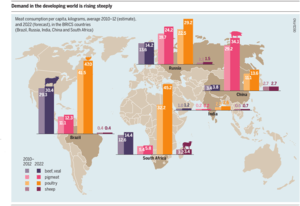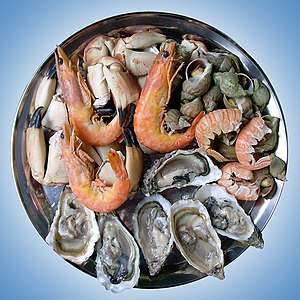Meat
Meat is animal flesh that is eaten as food.[1] Humans have hunted and killed animals for meat since prehistoric times. The advent of civilization allowed the domestication of animals such as chickens, sheep, rabbits, pigs and cattle. This eventually led to their use in meat production on an industrial scale with the aid of slaughterhouses.
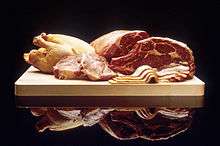
Meat is mainly composed of water, protein, and fat. It is edible raw, but is normally eaten after it has been cooked and seasoned or processed in a variety of ways. Unprocessed meat will spoil or rot within hours or days as a result of infection with and decomposition by bacteria and fungi.
Meat is important in economy and culture, even though its mass production and consumption has been determined to pose risks for human health and the environment. Many religions have rules about which meat may or may not be eaten. Vegetarians and vegans may abstain from eating meat because of concerns about the ethics of eating meat, environmental effects of meat production or nutritional effects of consumption.
Terminology
The word meat comes from the Old English word mete, which referred to food in general. The term is related to mad in Danish, mat in Swedish and Norwegian, and matur in Icelandic and Faroese, which also mean 'food'. The word mete also exists in Old Frisian (and to a lesser extent, modern West Frisian) to denote important food, differentiating it from swiets (sweets) and dierfied (animal feed).
Most often, meat refers to skeletal muscle and associated fat and other tissues, but it may also describe other edible tissues such as offal.[1]:1 Meat is sometimes also used in a more restrictive sense to mean the flesh of mammalian species (pigs, cattle, lambs, etc.) raised and prepared for human consumption, to the exclusion of fish, other seafood, insects, poultry, or other animals.[2][3]
In the context of food, meat can also refer to "the edible part of something as distinguished from its covering (such as a husk or shell)", for example, coconut meat.[3]
In English, there are also specialized terms for the meat of particular animals. These terms originated with the Norman conquest of England in 1066: while the animals retained their English names, their meat as brought to the tables of the invaders was referred to them with the Norman French words for the respective animal. In time, these appellations came to be used by the entire population.[4]
| Meat of... | ...is called: | Etymology |
|---|---|---|
| Pigs | Pork | Norman French porc (pig) |
| Cattle | Beef | Norman French boeuf (cattle) |
| Sheep | Mutton | Norman French mouton (sheep) |
| Calves | Veal | Norman French veau (calf) |
| Deer | Venison | Old French venesoun (meat of large game) |
History
Hunting and farming
Paleontological evidence suggests that meat constituted a substantial proportion of the diet of the earliest humans.[1]:2 Early hunter-gatherers depended on the organized hunting of large animals such as bison and deer.[1]:2
The domestication of animals, of which we have evidence dating back to the end of the last glacial period (c. 10,000 BCE),[1]:2 allowed the systematic production of meat and the breeding of animals with a view to improving meat production.[1]:2 Animals that are now principal sources of meat were domesticated in conjunction with the development of early civilizations:
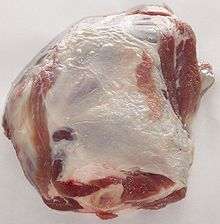
- Sheep, originating from western Asia, were domesticated with the help of dogs prior to the establishment of settled agriculture, likely as early as the 8th millennium BCE.[1]:3 Several breeds of sheep were established in ancient Mesopotamia and Egypt by 3500–3000 BCE.[1]:3 Today, more than 200 sheep-breeds exist.
- Cattle were domesticated in Mesopotamia after settled agriculture was established about 5000 BCE,[1]:5 and several breeds were established by 2500 BCE.[1]:6 Modern domesticated cattle fall into the groups Bos taurus (European cattle) and Bos taurus indicus (zebu), both descended from the now-extinct aurochs.[1]:5 The breeding of beef cattle, cattle optimized for meat production as opposed to animals best suited for work or dairy purposes, began in the middle of the 18th century.[1]:7
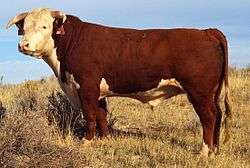
- Domestic pigs, which are descended from wild boars, are known to have existed about 2500 BCE in modern-day Hungary and in Troy; earlier pottery from Tell es-Sultan (Jericho) and Egypt depicts wild pigs.[1]:8 Pork sausages and hams were of great commercial importance in Greco-Roman times.[1]:8 Pigs continue to be bred intensively as they are being optimized to produce meat best suited for specific meat products.[1]:9
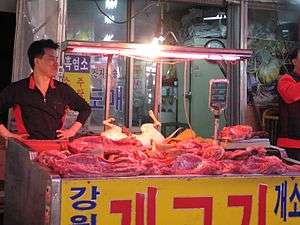
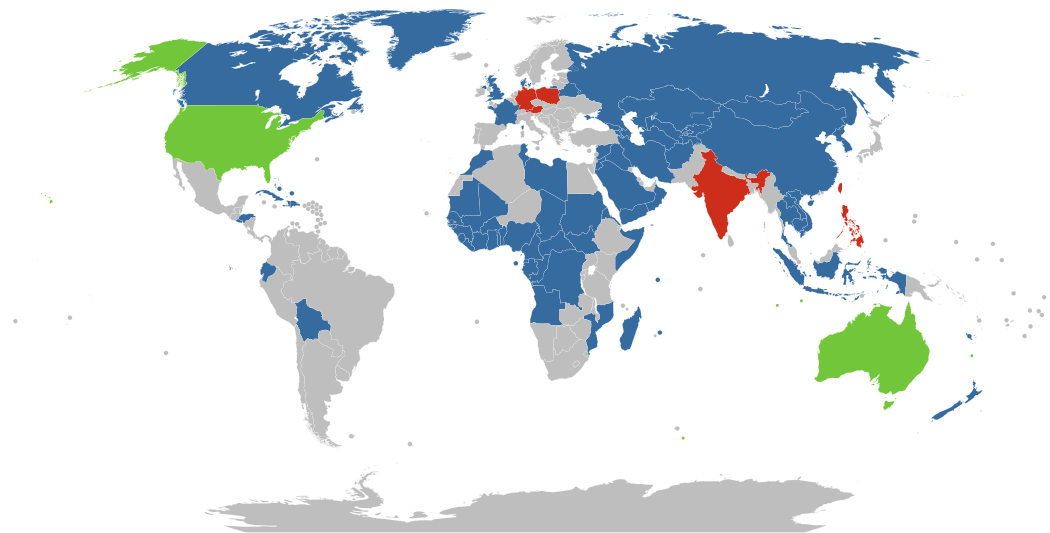
| | Dog killing is legal. | | Dog killing is partially illegal.1 |
| | Dog killing is illegal. | | Unknown |
Other animals are or have been raised or hunted for their flesh. The type of meat consumed varies much between different cultures, changes over time, depending on factors such as tradition and the availability of the animals. The amount and kind of meat consumed also varies by income, both between countries and within a given country.[5]
- Deer are hunted for their meat (venison) in various regions.
- Horses are commonly eaten in France,[6] Italy, Germany and Japan, among other countries.[7] Horses and other large mammals such as reindeer were hunted during the late Paleolithic in western Europe.[8]
- Dogs are consumed in China,[9] South Korea[10] and Vietnam.[11] Dogs are also occasionally eaten in the Arctic regions.[12] Historically, dog meat has been consumed in various parts of the world, such as Hawaii,[13] Japan,[14] Switzerland[15] and Mexico.[16]
- Cats are consumed in Southern China, Peru[17] and sometimes also in Northern Italy.[18][19]
- Guinea pigs are raised for their flesh in the Andes.[20]
- Whales and dolphins are hunted, partly for their flesh, in Japan, Alaska, Siberia, Canada, the Faroe Islands, Greenland, Iceland, Saint Vincent and the Grenadines and by two small communities in Indonesia.[21]
Modern agriculture employs a number of techniques, such as progeny testing, to speed artificial selection by breeding animals to rapidly acquire the qualities desired by meat producers.[1]:10 For instance, in the wake of well-publicised health concerns associated with saturated fats in the 1980s, the fat content of United Kingdom beef, pork and lamb fell from 20–26 percent to 4–8 percent within a few decades, due to both selective breeding for leanness and changed methods of butchery.[1]:10 Methods of genetic engineering aimed at improving the meat production qualities of animals are now also becoming available.[1]:14
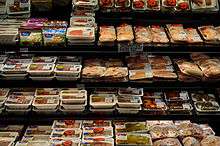
Even though it is a very old industry, meat production continues to be shaped strongly by the evolving demands of customers. The trend towards selling meat in pre-packaged cuts has increased the demand for larger breeds of cattle, which are better suited to producing such cuts.[1]:11 Even more animals not previously exploited for their meat are now being farmed, especially the more agile and mobile species, whose muscles tend to be developed better than those of cattle, sheep or pigs.[1]:11 Examples are the various antelope species, the zebra, water buffalo and camel,[1]:11ff as well as non-mammals, such as the crocodile, emu and ostrich.[1]:13 Another important trend in contemporary meat production is organic farming which, while providing no organoleptic benefit to meat so produced,[22] meets an increasing demand for organic meat.[23]
Culture
For most of human history, meat was a largely unquestioned part of the human diet.[24]:1 Only in the 20th century did it begin to become a topic of discourse and contention in society, politics and wider culture.[24]:11
Philosophy
The founders of Western philosophy disagreed about the ethics of eating meat. Plato's Republic has Socrates describe the ideal state as vegetarian. Pythagoras believed that humans and animals were equal and therefore disapproved of meat consumption, as did Plutarch, whereas Zeno and Epicurus were vegetarian but allowed meat-eating in their philosophy.[24]:10 Conversely, Aristotle's Politics assert that animals, as inferior beings, exist to serve humans, including as food. Augustine drew on Aristotle to argue that the universe's natural hierarchy allows humans to eat animals, and animals to eat plants.[24]:10 Enlightenment philosophers were likewise divided. Descartes wrote that animals are merely animated machines, and Kant considered them inferior beings for lack of discernment; means rather than ends.[24]:11 But Voltaire and Rousseau disagreed. The latter argued that meat-eating is a social rather than a natural act, because children are not interested in meat.[24]:11
Later philosophers examined the changing practices of eating meat in the modern age as part of a process of detachment from animals as living beings. Norbert Elias, for instance, noted that in medieval times cooked animals were brought to the table whole, but that since the Renaissance only the edible parts are served, which are no longer recognizably part of an animal.[24]:12 Modern eaters, according to Noëlie Vialles, demand an "ellipsis" between meat and dead animals; for instance, calves' eyes are no longer considered a delicacy as in the Middle Ages, but provoke disgust.[24]:12 Even in the English language, distinctions emerged between animals and their meat, such as between cattle and beef, pigs and pork.[24]:12 Fernand Braudel wrote that since the European diet of the 15th and 16th century was particularly heavy in meat, European colonialism helped export meat-eating across the globe, as colonized peoples took up the culinary habits of their colonizers, which they associated with wealth and power.[24]:15
Consumption
| Animals | Number Killed |
|---|---|
| Chickens | 61,171,973,510 |
| Ducks | 2,887,594,480 |
| Pigs | 1,451,856,889 |
| Rabbits | 1,171,578,000 |
| Geese | 687,147,000 |
| Turkeys | 618,086,890 |
| Sheep | 536,742,256 |
| Goats | 438,320,370 |
| Cattle | 298,799,160 |
| Rodents | 70,371,000 |
| Pigeons and other birds | 59,656,000 |
| Buffalo | 25,798,819 |
| Horses | 4,863,367 |
| Donkeys and mules | 3,478,300 |
| Camels and other camelids | 3,298,266 |
Meat consumption varies worldwide, depending on cultural or religious preferences, as well as economic conditions. Vegetarians and vegans choose not to eat meat because of ethical, economic, environmental, religious or health concerns that are associated with meat production and consumption.
According to the analysis of the FAO the overall consumption for white meat between 1990 and 2009 has dramatically increased. Poultry meat has increased by 76.6% per kilo per capita and pig meat by 19.7%. Bovine meat has decreased from 10.4 kg (22 lb 15 oz) per capita in 1990 to 9.6 kg (21 lb 3 oz) per capita in 2009.[28]
Overall, diets that include meat are the most common worldwide according to the results of a 2018 Ipsos MORI study of 16–64 years olds in 28 different countries. Ipsos states “An omnivorous diet is the most common diet globally, with non-meat diets (which can include fish) followed by over a tenth of the global population.” Approximately 87% of people include meat in their diet in some frequency. 73% of meat eaters included it in their diet regularly and 14% consumed meat only occasionally or infrequently. Estimates of the non-meat diets were also broken down. About 3% of people followed vegan diets; where consumption of meat, eggs, and dairy are abstained from. About 5% of people followed vegetarian diets; where consumption of meat is abstained from, but egg and/or dairy consumption is not strictly restricted. About 3% of people followed pescetarian diets; where consumption of the meat of land animals is abstained from, fish meat and other seafood is consumed, and egg and/or dairy consumption may or may not be strictly restricted.[29]
Animal growth and development
Agricultural science has identified several factors bearing on the growth and development of meat in animals.
Genetics
| Trait | Heritability[30] |
|---|---|
| Reproductive efficiency | 2–10% |
| Meat quality | 15–30% |
| Growth | 20–40% |
| Muscle/fat ratio | 40–60% |
Several economically important traits in meat animals are heritable to some degree (see the adjacent table) and can thus be selected for by animal breeding. In cattle, certain growth features are controlled by recessive genes which have not so far been controlled, complicating breeding.[1]:18 One such trait is dwarfism; another is the doppelender or "double muscling" condition, which causes muscle hypertrophy and thereby increases the animal's commercial value.[1]:18 Genetic analysis continues to reveal the genetic mechanisms that control numerous aspects of the endocrine system and, through it, meat growth and quality.[1]:19
Genetic engineering techniques can shorten breeding programs significantly because they allow for the identification and isolation of genes coding for desired traits, and for the reincorporation of these genes into the animal genome.[1]:21 To enable such manipulation, research is ongoing (as of 2006) to map the entire genome of sheep, cattle and pigs.[1]:21 Some research has already seen commercial application. For instance, a recombinant bacterium has been developed which improves the digestion of grass in the rumen of cattle, and some specific features of muscle fibres have been genetically altered.[1]:22
Experimental reproductive cloning of commercially important meat animals such as sheep, pig or cattle has been successful. Multiple asexual reproduction of animals bearing desirable traits is anticipated,[1]:22 although this is not yet practical on a commercial scale.
Environment
Heat regulation in livestock is of great economic significance, because mammals attempt to maintain a constant optimal body temperature. Low temperatures tend to prolong animal development and high temperatures tend to retard it.[1]:22 Depending on their size, body shape and insulation through tissue and fur, some animals have a relatively narrow zone of temperature tolerance and others (e.g. cattle) a broad one.[1]:23 Static magnetic fields, for reasons still unknown, also retard animal development.[1]:23
Nutrition
The quality and quantity of usable meat depends on the animal's plane of nutrition, i.e., whether it is over- or underfed. Scientists disagree about how exactly the plane of nutrition influences carcass composition.[1]:25
The composition of the diet, especially the amount of protein provided, is also an important factor regulating animal growth.[1]:26 Ruminants, which may digest cellulose, are better adapted to poor-quality diets, but their ruminal microorganisms degrade high-quality protein if supplied in excess.[1]:27 Because producing high-quality protein animal feed is expensive (see also Environmental impact below), several techniques are employed or experimented with to ensure maximum utilization of protein. These include the treatment of feed with formalin to protect amino acids during their passage through the rumen, the recycling of manure by feeding it back to cattle mixed with feed concentrates, or the partial conversion of petroleum hydrocarbons to protein through microbial action.[1]:30
In plant feed, environmental factors influence the availability of crucial nutrients or micronutrients, a lack or excess of which can cause a great many ailments.[1]:29 In Australia, for instance, where the soil contains limited phosphate, cattle are being fed additional phosphate to increase the efficiency of beef production.[1]:28 Also in Australia, cattle and sheep in certain areas were often found losing their appetite and dying in the midst of rich pasture; this was at length found to be a result of cobalt deficiency in the soil.[1]:29 Plant toxins are also a risk to grazing animals; for instance, sodium fluoroacetate, found in some African and Australian plants, kills by disrupting the cellular metabolism.[1]:29 Certain man-made pollutants such as methylmercury and some pesticide residues present a particular hazard due to their tendency to bioaccumulate in meat, potentially poisoning consumers.[1]:30
Human intervention
Meat producers may seek to improve the fertility of female animals through the administration of gonadotrophic or ovulation-inducing hormones.[1]:31 In pig production, sow infertility is a common problem — possibly due to excessive fatness.[1]:32 No methods currently exist to augment the fertility of male animals.[1]:32 Artificial insemination is now routinely used to produce animals of the best possible genetic quality, and the efficiency of this method is improved through the administration of hormones that synchronize the ovulation cycles within groups of females.[1]:33
Growth hormones, particularly anabolic agents such as steroids, are used in some countries to accelerate muscle growth in animals.[1]:33 This practice has given rise to the beef hormone controversy, an international trade dispute. It may also decrease the tenderness of meat, although research on this is inconclusive,[1]:35 and have other effects on the composition of the muscle flesh.[1]:36ff Where castration is used to improve control over male animals, its side effects are also counteracted by the administration of hormones.[1]:33
Sedatives may be administered to animals to counteract stress factors and increase weight gain.[1]:39 The feeding of antibiotics to certain animals has been shown to improve growth rates also.[1]:39 This practice is particularly prevalent in the USA, but has been banned in the EU, partly because it causes antimicrobial resistance in pathogenic microorganisms.[1]:39
Biochemical composition
Numerous aspects of the biochemical composition of meat vary in complex ways depending on the species, breed, sex, age, plane of nutrition, training and exercise of the animal, as well as on the anatomical location of the musculature involved.[1]:94–126 Even between animals of the same litter and sex there are considerable differences in such parameters as the percentage of intramuscular fat.[1]:126
Main constituents
Adult mammalian muscle flesh consists of roughly 75 percent water, 19 percent protein, 2.5 percent intramuscular fat, 1.2 percent carbohydrates and 2.3 percent other soluble non-protein substances. These include nitrogenous compounds, such as amino acids, and inorganic substances such as minerals.[1]:76
Muscle proteins are either soluble in water (sarcoplasmic proteins, about 11.5 percent of total muscle mass) or in concentrated salt solutions (myofibrillar proteins, about 5.5 percent of mass).[1]:75 There are several hundred sarcoplasmic proteins.[1]:77 Most of them – the glycolytic enzymes – are involved in the glycolytic pathway, i.e., the conversion of stored energy into muscle power.[1]:78 The two most abundant myofibrillar proteins, myosin and actin,[1]:79 are responsible for the muscle's overall structure. The remaining protein mass consists of connective tissue (collagen and elastin) as well as organelle tissue.[1]:79
Fat in meat can be either adipose tissue, used by the animal to store energy and consisting of "true fats" (esters of glycerol with fatty acids),[1]:82 or intramuscular fat, which contains considerable quantities of phospholipids and of unsaponifiable constituents such as cholesterol.[1]:82
Red and white
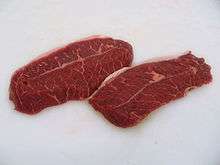
Meat can be broadly classified as "red" or "white" depending on the concentration of myoglobin in muscle fibre. When myoglobin is exposed to oxygen, reddish oxymyoglobin develops, making myoglobin-rich meat appear red. The redness of meat depends on species, animal age, and fibre type: Red meat contains more narrow muscle fibres that tend to operate over long periods without rest,[1]:93 while white meat contains more broad fibres that tend to work in short fast bursts.[1]:93
Generally, the meat of adult mammals such as cows, sheep, and horses is considered red, while chicken and turkey breast meat is considered white.[31]
Nutritional information
| Source | Energy: kJ (kcal) | Protein | Carbs | Fat |
|---|---|---|---|---|
| Fish | 460–590 (110–140) | 20–25 g | 0 g | 1–5 g |
| Chicken breast | 670 (160) | 28 g | 0 g | 7 g |
| Lamb | 1,000 (250) | 30 g | 0 g | 14 g |
| Steak (beef top round) | 880 (210) | 36 g | 0 g | 7 g |
| Steak (beef T-bone) | 1,900 (450) | 25 g | 0 g | 35 g |
| Dog (various cuts)[32] | 1,100 (270) | 20 g | 0 g | 22 g |
| Horse (strip steak)[33] | 590 (140) | 25 g | 0 g | 7 g |
| Pork loin[34] | 1,010 (242) | 14 g | 0 g | 30 g |
| Rabbit (domesticated)[35] | 900 (215) | 32 g | 0 g | 9 g |
All muscle tissue is very high in protein, containing all of the essential amino acids, and in most cases is a good source of zinc, vitamin B12, selenium, phosphorus, niacin, vitamin B6, choline, riboflavin and iron.[36] Several forms of meat are also high in vitamin K.[37] Muscle tissue is very low in carbohydrates and does not contain dietary fiber.[38] While taste quality may vary between meats, the proteins, vitamins, and minerals available from meats are generally consistent.
The fat content of meat can vary widely depending on the species and breed of animal, the way in which the animal was raised, including what it was fed, the anatomical part of the body, and the methods of butchering and cooking. Wild animals such as deer are typically leaner than farm animals, leading those concerned about fat content to choose game such as venison. Decades of breeding meat animals for fatness is being reversed by consumer demand for meat with less fat. The fatty deposits that exist with the muscle fibers in meats soften meat when it is cooked and improve the flavor through chemical changes initiated through heat that allow the protein and fat molecules to interact. The fat, when cooked with meat, also makes the meat seem juicier. The nutritional contribution of the fat is mainly calories as opposed to protein. As fat content rises, the meat's contribution to nutrition declines. In addition, there is cholesterol associated with fat surrounding the meat. The cholesterol is a lipid associated with the kind of saturated fat found in meat. The increase in meat consumption after 1960 is associated with, though not definitively the cause of, significant imbalances of fat and cholesterol in the human diet.[39]
The table in this section compares the nutritional content of several types of meat. While each kind of meat has about the same content of protein and carbohydrates, there is a very wide range of fat content.
Production
Meat is produced by killing an animal and cutting flesh out of it. These procedures are called slaughter and butchery, respectively. There is ongoing research into producing meat in vitro; that is, outside of animals.
Transport
Upon reaching a predetermined age or weight, livestock are usually transported en masse to the slaughterhouse. Depending on its length and circumstances, this may exert stress and injuries on the animals, and some may die en route.[1]:129 Unnecessary stress in transport may adversely affect the quality of the meat.[1]:129 In particular, the muscles of stressed animals are low in water and glycogen, and their pH fails to attain acidic values, all of which results in poor meat quality.[1]:130 Consequently, and also due to campaigning by animal welfare groups, laws and industry practices in several countries tend to become more restrictive with respect to the duration and other circumstances of livestock transports.
Slaughter
Animals are usually slaughtered by being first stunned and then exsanguinated (bled out). Death results from the one or the other procedure, depending on the methods employed. Stunning can be effected through asphyxiating the animals with carbon dioxide, shooting them with a gun or a captive bolt pistol, or shocking them with electric current.[1]:134ff In most forms of ritual slaughter, stunning is not allowed.
Draining as much blood as possible from the carcass is necessary because blood causes the meat to have an unappealing appearance and is a breeding ground for microorganisms.[1]:1340 The exsanguination is accomplished by severing the carotid artery and the jugular vein in cattle and sheep, and the anterior vena cava in pigs.[1]:137
The act of slaughtering animals for meat, or of raising or transporting animals for slaughter, may engender both psychological stress[40] and physical trauma[41] in the people involved. Additionally, slaughterhouse workers are exposed to noise of between 76 and 100 dB from the screams of animals being killed. 80 dB is the threshold at which the wearing of ear protection is recommended.[42]
Dressing and cutting
After exsanguination, the carcass is dressed; that is, the head, feet, hide (except hogs and some veal), excess fat, viscera and offal are removed, leaving only bones and edible muscle.[1]:138 Cattle and pig carcases, but not those of sheep, are then split in half along the mid ventral axis, and the carcase is cut into wholesale pieces.[1]:138 The dressing and cutting sequence, long a province of manual labor, is progressively being fully automated.[1]:138
Conditioning
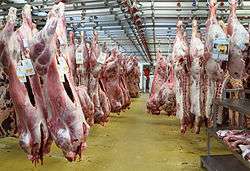
Under hygienic conditions and without other treatment, meat can be stored at above its freezing point (–1.5 °C) for about six weeks without spoilage, during which time it undergoes an aging process that increases its tenderness and flavor.[1]:141
During the first day after death, glycolysis continues until the accumulation of lactic acid causes the pH to reach about 5.5. The remaining glycogen, about 18 g per kg, is believed to increase the water-holding capacity and tenderness of the flesh when cooked.[1]:87 Rigor mortis sets in a few hours after death as ATP is used up, causing actin and myosin to combine into rigid actomyosin and lowering the meat's water-holding capacity,[1]:90 causing it to lose water ("weep").[1]:146 In muscles that enter rigor in a contracted position, actin and myosin filaments overlap and cross-bond, resulting in meat that is tough on cooking[1]:144 – hence again the need to prevent pre-slaughter stress in the animal.
Over time, the muscle proteins denature in varying degree, with the exception of the collagen and elastin of connective tissue,[1]:142 and rigor mortis resolves. Because of these changes, the meat is tender and pliable when cooked just after death or after the resolution of rigor, but tough when cooked during rigor.[1]:142 As the muscle pigment myoglobin denatures, its iron oxidates, which may cause a brown discoloration near the surface of the meat.[1]:146 Ongoing proteolysis also contributes to conditioning. Hypoxanthine, a breakdown product of ATP, contributes to the meat's flavor and odor, as do other products of the decomposition of muscle fat and protein.[1]:155
Additives
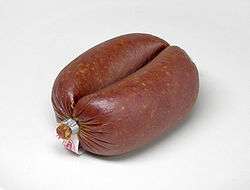
When meat is industrially processed in preparation of consumption, it may be enriched with additives to protect or modify its flavor or color, to improve its tenderness, juiciness or cohesiveness, or to aid with its preservation. Meat additives include the following:[44]
- Salt is the most frequently used additive in meat processing. It imparts flavor but also inhibits microbial growth, extends the product's shelf life and helps emulsifying finely processed products, such as sausages. Ready-to-eat meat products normally contain about 1.5 to 2.5 percent salt.[44] Salt water or similar substances may also be injected into poultry meat to improve the taste and increase the weight, in a process called plumping.
- Nitrite is used in curing meat to stabilize the meat's color and flavor, and inhibits the growth of spore-forming microorganisms such as C. botulinum. The use of nitrite's precursor nitrate is now limited to a few products such as dry sausage, prosciutto or parma ham.[44]
- Phosphates used in meat processing are normally alkaline polyphosphates such as sodium tripolyphosphate. They are used to increase the water-binding and emulsifying ability of meat proteins, but also limit lipid oxidation and flavor loss, and reduce microbial growth.[44]
- Erythorbate or its equivalent ascorbic acid (vitamin C) is used to stabilize the color of cured meat.[44]
- Sweeteners such as sugar or corn syrup impart a sweet flavor, bind water and assist surface browning during cooking in the Maillard reaction.[44]
- Seasonings impart or modify flavor. They include spices or oleoresins extracted from them, herbs, vegetables and essential oils.[44]
- Flavorings such as monosodium glutamate impart or strengthen a particular flavor.[44]
- Tenderizers break down collagens to make the meat more palatable for consumption. They include proteolytic enzymes, acids, salt and phosphate.[44]
- Dedicated antimicrobials include lactic, citric and acetic acid, sodium diacetate, acidified sodium chloride or calcium sulfate, cetylpyridinium chloride, activated lactoferrin, sodium or potassium lactate, or bacteriocins such as nisin.[44]
- Antioxidants include a wide range of chemicals that limit lipid oxidation, which creates an undesirable "off flavor", in precooked meat products.[44]
- Acidifiers, most often lactic or citric acid, can impart a tangy or tart flavor note, extend shelf-life, tenderize fresh meat or help with protein denaturation and moisture release in dried meat. They substitute for the process of natural fermentation that acidifies some meat products such as hard salami or prosciutto.[44]
Misidentification
With the rise of complex supply chains, including cold chains, in developed economies, the distance between the farmer or fisherman and customer has grown, increasing the possibility for intentional and unintentional misidentification of meat at various points in the supply chain.[45]
In 2013, reports emerged across Europe that products labelled as containing beef actually contained horse meat.[46] In February 2013 a study was published showing that about one-third of raw fish are misidentified across the United States.[45]
Imitation
Various forms of imitation meat have been created for people who wish not to eat meat but still want to taste its flavor and texture. Meat imitates are typically some form of processed soybean (tofu, tempeh), but they can also be based on wheat gluten, pea protein isolate, or even fungi (quorn).
Environmental impact
Various environmental effects are associated with meat production. Among these are greenhouse gas emissions, fossil energy use, water use, water quality changes, and effects on grazed ecosystems.
The livestock sector may be the largest source of water pollution (due to animal wastes, fertilizers, pesticides), and it contributes to emergence of antibiotic resistance. It accounts for over 8% of global human water use. It It is a significant driver of biodiversity loss, as it causes deforestation, ocean dead zones, land degradation, pollution, and overfishing.[48][49][50][51][52]
The occurrence, nature and significance of environmental effects varies among livestock production systems.[53] Grazing of livestock can be beneficial for some wildlife species, but not for others.[54][55] Targeted grazing of livestock is used as a food-producing alternative to herbicide use in some vegetation management.[56]
Land use
Meat production is by far the biggest cause of land use, as it accounts for nearly 40% of the global land surface.[57] Just in the contiguous United States, 34% of its land area (654 million acres) are used as pasture and rangeland, mostly feeding livestock, not counting 391 million acres of cropland (20%), some of which is used for producing feed for livestock.[58]
Climate change
Meat production is responsible for 14.5% and possibly up to 51% of the world's anthropogenic greenhouse gas emissions.[59][60] Greenhouse gas emission depends on the economy and country: animal products (meat, fish, and dairy) account for 22%, 65%, and 70% of emissions in the diets of lower-middle–, upper-middle–, and high-income nations, respectively. Some nations show very different impacts to counterparts within the same group, with Brazil and Australia having emissions over 200% higher than the average of their respective income groups and driven by meat consumption.[61]
According to the Assessing the Environmental Impacts of Consumption and Production report produced by United Nations Environment Programme's (UNEP) international panel for sustainable resource management, a worldwide transition in the direction of a meat and dairy free diet is indispensable if adverse global climate change were to be prevented.[62] A 2019 report in The Lancet recommended that global meat (and sugar) consumption be reduced by 50 percent to mitigate climate change.[63] Meat consumption in Western societies needs to be reduced by up to 90% according to a 2018 study published in Nature.[64][65] The 2019 special report by the Intergovernmental Panel on Climate Change advocated for significantly reducing meat consumption, particularly in wealthy countries, in order to mitigate and adapt to climate change.[66]
Biodiversity loss
Meat consumption is considered one of the primary contributors of the sixth mass extinction.[51][67][68][69] A 2017 study by the World Wildlife Fund found that 60% of global biodiversity loss is attributable to meat-based diets, in particular from the vast scale of feed crop cultivation needed to rear tens of billions of farm animals for human consumption puts an enormous strain on natural resources resulting in a wide-scale loss of lands and species.[70] Currently, livestock make up 60% of the biomass of all mammals on earth, followed by humans (36%) and wild mammals (4%).[71][72] In November 2017, 15,364 world scientists signed a Warning to Humanity calling for, among other things, drastically diminishing our per capita consumption of meat and "dietary shifts towards mostly plant-based foods".[73] The 2019 Global Assessment Report on Biodiversity and Ecosystem Services, released by IPBES, also recommended reductions in meat consumption in order to mitigate biodiversity loss.[74]
A July 2018 study in Science says that meat consumption is set to rise as the human population increases along with affluence, which will increase greenhouse gas emissions and further reduce biodiversity.[75]
Reducing environmental impact
The environmental impact of meat production can be reduced by conversion of human-inedible residues of food crops.[76][77] Manure from meat-producing livestock is used as fertilizer; it may be composted before application to food crops. Substitution of animal manures for synthetic fertilizers in crop production can be environmentally significant, as between 43 and 88 MJ of fossil fuel energy are used per kg of nitrogen in manufacture of synthetic nitrogenous fertilizers.[78]
Spoilage and preservation
The spoilage of meat occurs, if untreated, in a matter of hours or days and results in the meat becoming unappetizing, poisonous or infectious. Spoilage is caused by the practically unavoidable infection and subsequent decomposition of meat by bacteria and fungi, which are borne by the animal itself, by the people handling the meat, and by their implements. Meat can be kept edible for a much longer time – though not indefinitely – if proper hygiene is observed during production and processing, and if appropriate food safety, food preservation and food storage procedures are applied. Without the application of preservatives and stabilizers, the fats in meat may also begin to rapidly decompose after cooking or processing, leading to an objectionable taste known as warmed over flavor.
Methods of preparation

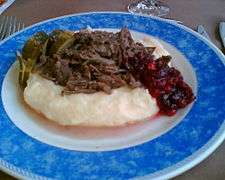
Fresh meat can be cooked for immediate consumption, or be processed, that is, treated for longer-term preservation and later consumption, possibly after further preparation. Fresh meat cuts or processed cuts may produce iridescence, commonly thought to be due to spoilage but actually caused by structural coloration and diffraction of the light.[79] A common additive to processed meats for both preservation and the prevention of discoloration is sodium nitrite. This substance is a source of health concerns because it may form carcinogenic nitrosamines when heated.[80]
Meat is prepared in many ways, as steaks, in stews, fondue, or as dried meat like beef jerky. It may be ground then formed into patties (as hamburgers or croquettes), loaves, or sausages, or used in loose form (as in "sloppy joe" or Bolognese sauce).
Some meat is cured by smoking, which is the process of flavoring, cooking, or preserving food by exposing it to the smoke from burning or smoldering plant materials, most often wood. In Europe, alder is the traditional smoking wood, but oak is more often used now, and beech to a lesser extent. In North America, hickory, mesquite, oak, pecan, alder, maple, and fruit-tree woods are commonly used for smoking. Meat can also be cured by pickling, preserving in salt or brine (see salted meat and other curing methods). Other kinds of meat are marinated and barbecued, or simply boiled, roasted, or fried.
Meat is generally eaten cooked, but many recipes call for raw beef, veal or fish (tartare). Steak tartare is a meat dish made from finely chopped or minced raw beef or horse meat.[81][82] Meat is often spiced or seasoned, particularly with meat products such as sausages. Meat dishes are usually described by their source (animal and part of body) and method of preparation (e.g., a beef rib).
Meat is a typical base for making sandwiches. Popular varieties of sandwich meat include ham, pork, salami and other sausages, and beef, such as steak, roast beef, corned beef, pepperoni, and pastrami. Meat can also be molded or pressed (common for products that include offal, such as haggis and scrapple) and canned.
Health
There is concern and debate regarding the potential association of meat, in particular red and processed meat, with a variety of health risks. A study of 400,000 subjects conducted by the European Prospective Investigation into Cancer and Nutrition and published in 2013 showed "a moderate positive association between processed meat consumption and mortality, in particular due to cardiovascular diseases, but also to cancer."[83]
A 1999 metastudy combined data from five studies from western countries. The metastudy reported mortality ratios, where lower numbers indicated fewer deaths, for fish eaters to be 0.82, vegetarians to be 0.84, occasional meat eaters to be 0.84. Regular meat eaters and vegans shared the highest mortality ratio of 1.00.[84]
In response to changing prices as well as health concerns about saturated fat and cholesterol (see lipid hypothesis), consumers have altered their consumption of various meats. A USDA report points out that consumption of beef in the United States between 1970–1974 and 1990–1994 dropped by 21%, while consumption of chicken increased by 90%.[85] During the same period of time, the price of chicken dropped by 14% relative to the price of beef. From 1995–1996, beef consumption increased due to higher supplies and lower prices.
The 2015–2020 Dietary Guidelines for Americans asked men and teenage boys to increase their consumption of vegetables or other underconsumed foods (fruits, whole grains, and dairy) while reducing intake of protein foods (meats, poultry, and eggs) that they currently overconsume.[86]
The health effects of red meat are unclear as of 2019.[87]
Contamination
Various toxic compounds can contaminate meat, including heavy metals, mycotoxins, pesticide residues, dioxins, polychlorinated biphenyl (PCBs). Processed, smoked and cooked meat may contain carcinogens such as polycyclic aromatic hydrocarbons.[88]
Toxins may be introduced to meat as part of animal feed, as veterinary drug residues, or during processing and cooking. Often, these compounds can be metabolized in the body to form harmful by-products. Negative effects depend on the individual genome, diet, and history of the consumer.[89] Any chemical's toxicity is also dependent on the dose and timing of exposure.
Cancer
There are concerns about a relationship between the consumption of meat, in particular processed and red meat, and increased cancer risk. The International Agency for Research on Cancer (IARC), a specialized agency of the World Health Organization (WHO), classified processed meat (e.g., bacon, ham, hot dogs, sausages) as, "carcinogenic to humans (Group 1), based on sufficient evidence in humans that the consumption of processed meat causes colorectal cancer." IARC also classified red meat as "probably carcinogenic to humans (Group 2A), based on limited evidence that the consumption of red meat causes cancer in humans and strong mechanistic evidence supporting a carcinogenic effect."[90][91][92]
Heart disease
The correlation of consumption to increased risk of heart disease is controversial. Some studies fail to find a link between red meat consumption and heart disease[93] (although the same study found statistically significant correlation between the consumption of processed meat and coronary heart disease). A large cohort study of Seventh-Day Adventists in California found that the risk of heart disease is three times greater for 45-64-year-old men who eat meat daily, versus those who did not eat meat. This study compared adventists to the general population and not other Seventh Day Adventists who ate meat and did not specifically distinguish red and processed meat in its assessment.[94]
A major Harvard University study[95] in 2010 involving over one million people who ate meat found that only processed meat had an adverse risk in relation to coronary heart disease. The study suggests that eating 50 g (less than 2 ounces) of processed meat per day increases risk of coronary heart disease by 42%, and diabetes by 19%. Equivalent levels of fat, including saturated fats, in unprocessed meat (even when eating twice as much per day) did not show any deleterious effects, leading the researchers to suggest that "differences in salt and preservatives, rather than fats, might explain the higher risk of heart disease and diabetes seen with processed meats, but not with unprocessed red meats." A 2017 meta-analyses of randomized controlled trials found that eating more than 0.5 servings of meat per-day does not increase lipids, blood pressure, lipoproteins, or other heart disease risk factors.[96]
Obesity
Prospective analysis suggests that meat consumption is positively associated with weight gain in men and women.[97] The National Cattlemen's Beef Association countered by stating that meat consumption may not be associated with fat gain.[98] In response, the authors of the original study controlled for just abdominal fat across a sample of 91,214 people and found that even when controlling for calories and lifestyle factors, meat consumption is linked with obesity.[99] Additional studies and reviews have confirmed the finding that greater meat consumption is positively linked with greater weight gain even when controlling for calories, and lifestyle factors.[100][101]
Bacterial contamination
Bacterial contamination has been seen with meat products. A 2011 study by the Translational Genomics Research Institute showed that nearly half (47%) of the meat and poultry in U.S. grocery stores were contaminated with S. aureus, with more than half (52%) of those bacteria resistant to antibiotics.[102] A 2018 investigation by the Bureau of Investigative Journalism and The Guardian found that around 15 percent of the US population suffers from foodborne illnesses every year. The investigation also highlighted unsanitary conditions in US-based meat plants, which included meat products covered in excrement and abscesses "filled with pus".[103]
Cooking
Meat can transmit certain diseases, but complete cooking and avoiding recontamination reduces this possibility.[104]
Several studies published since 1990 indicate that cooking muscle meat creates heterocyclic amines (HCAs), which are thought to increase cancer risk in humans. Researchers at the National Cancer Institute published results of a study which found that human subjects who ate beef rare or medium-rare had less than one third the risk of stomach cancer than those who ate beef medium-well or well-done.[105] While eating muscle meat raw may be the only way to avoid HCAs fully, the National Cancer Institute states that cooking meat below 100 °C (212 °F) creates "negligible amounts" of HCAs. Also, microwaving meat before cooking may reduce HCAs by 90%.[106]
Nitrosamines, present in processed and cooked foods, have been noted as being carcinogenic, being linked to colon cancer. Also, toxic compounds called PAHs, or polycyclic aromatic hydrocarbons, present in processed, smoked and cooked foods, are known to be carcinogenic.[88]
Sociology
Meat is part of the human diet in most cultures, where it often has symbolic meaning and important social functions.[107] Some people choose not to eat meat (vegetarianism) or any food made from animals (veganism). The reasons for not eating all or some meat may include ethical objections to killing animals for food, health concerns, environmental concerns or religious dietary laws.
Ethics
Ethical issues regarding the consumption of meat include objecting to the act of killing animals or to the agricultural practices used in meat production. Reasons for objecting to killing animals for consumption may include animal rights, environmental ethics, or an aversion to inflicting pain or harm on other sentient creatures. Some people, while not vegetarians, refuse to eat the flesh of certain animals (such as cows, pigs, cats, dogs, horses, or rabbits) due to cultural or religious traditions.
Some people eat only the flesh of animals that they believe have not been mistreated, and abstain from the flesh of animals raised in factory farms or else abstain from particular products, such as foie gras and veal.
Some techniques of intensive agriculture may be cruel to animals: foie gras is a food product made from the liver of ducks or geese that have been force fed corn to fatten the organ; veal is criticised because the veal calves may be highly restricted in movement, have unsuitable flooring, spend their entire lives indoors, experience prolonged deprivation (sensory, social, and exploratory), and be more susceptible to high amounts of stress and disease.[108]
Religious traditions
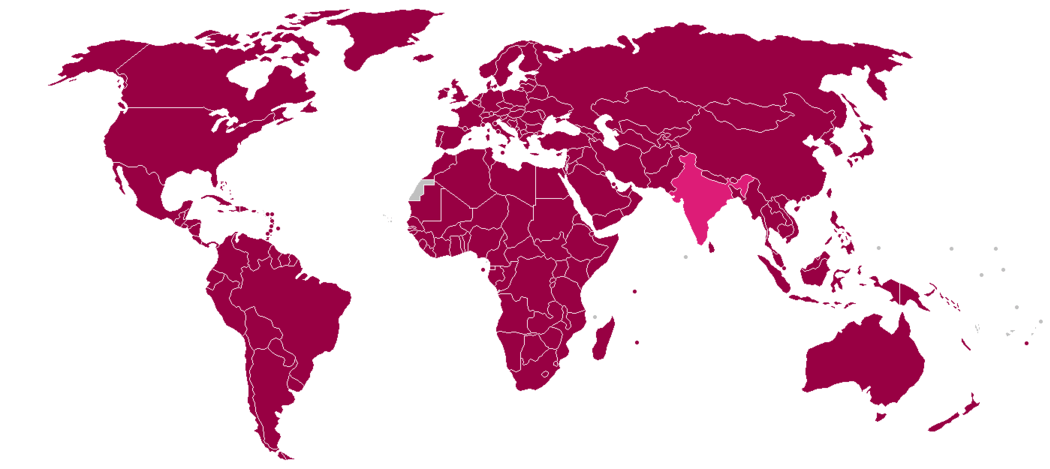
| | Cattle killing is legal | | Cattle killing is partially illegal1 |
| | Unknown |
The religion of Jainism has always opposed eating meat, and there are also schools of Buddhism and Hinduism that condemn the eating of meat.
Jewish dietary rules (Kashrut) allow certain (kosher) meat and forbid other (treif). The rules include prohibitions on the consumption of unclean animals (such as pork, shellfish including mollusca and crustacea, and most insects), and mixtures of meat and milk.
Similar rules apply in Islamic dietary laws: The Quran explicitly forbids meat from animals that die naturally, blood, the meat of swine (porcine animals, pigs), and animals dedicated to other than Allah (either undedicated or dedicated to idols) which are haram as opposed to halal.
Sikhism forbids meat of slowly slaughtered animals ("kutha") and prescribes killing animals with a single strike ("jhatka"), but some Sikh groups oppose eating any meat.[109]
Psychology
Research in applied psychology has investigated practices of meat eating in relation to morality, emotions, cognition, and personality characteristics.[110] Psychological research suggests meat eating is correlated with masculinity,[111] support for social hierarchy,[112] and reduced openness to experience.[113] Research into the consumer psychology of meat is relevant both to meat industry marketing[114] and to advocates of reduced meat consumption.[115][116]
Gender
Unlike most other food, meat is not perceived as gender-neutral, and is particularly associated with men and masculinity. Sociological research, ranging from African tribal societies to contemporary barbecues, indicates that men are much more likely to participate in preparing meat than other food.[24]:15 This has been attributed to the influence of traditional male gender roles, in view of a "male familiarity with killing" (Goody) or roasting being more violent as opposed to boiling (Lévi-Strauss).[24]:15 By and large, at least in modern societies, men also tend to consume more meat than women, and men often prefer red meat whereas women tend to prefer chicken and fish.[24]:16
See also
- Alligator meat
- Bushmeat
- Carnism
- Cheap meat
- Culinary name
- Dog meat
- Food industry
- Food science
- Gristle
- List of domesticated meat animals
- List of meat dishes
- List of foods
- Meat Atlas
- Meat on the bone
- Meat-free days
- Mechanically separated meat
- Mystery meat
- Roadkill cuisine
- Tendon
- Cat meat
References
- Lawrie, R.A.; Ledward, D A. (2006). Lawrie's meat science (7th ed.). Cambridge: Woodhead Publishing Limited. ISBN 978-1-84569-159-2.
- "Meat definition and meaning | Collins English Dictionary". www.collinsdictionary.com. Archived from the original on July 12, 2017. Retrieved June 16, 2017.
- "Definition of MEAT". www.merriam-webster.com. Archived from the original on March 19, 2018. Retrieved June 16, 2017.
- "Pig or Pork? Cow or Beef?". Voice of America. Retrieved August 4, 2020.
- Mark Gehlhar and William Coyle, "Global Food Consumption and Impacts on Trade Patterns" Archived September 5, 2012, at the Wayback Machine, Chapter 1 in Changing Structure of Global Food Consumption and Trade Archived February 26, 2013, at the Wayback Machine, edited by Anita Regmi, May 2001. USDA Economic Research Service.
- Chrisafis, Angelique "France's horsemeat lovers fear US ban Archived September 20, 2017, at the Wayback Machine The Guardian, June 15, 2007, London.
- Alan Davidson (2006). Tom Jaine, Jane Davidson and Helen Saberi. ed. The Oxford Companion to Food. Oxford: Oxford University Press. ISBN 0-19-280681-5, pp. 387–88
- Turner, E. 2005. "Results of a recent analysis of horse remains dating to the Magdalenian period at Solutre, France," pp. 70–89. In Mashkour, M (ed.). Equids in Time and Space. Oxford: Oxbow
- "BBC NEWS – Programmes – From Our Own Correspondent – China's taste for the exotic". bbc.co.uk. June 29, 2002. Archived from the original on February 1, 2011. Retrieved February 4, 2011.
- Podberscek, A.L. (2009). "Good to Pet and Eat: The Keeping and Consuming of Dogs and Cats in South Korea" (PDF). Journal of Social Issues. 65 (3): 615–632. CiteSeerX 10.1.1.596.7570. doi:10.1111/j.1540-4560.2009.01616.x. Archived from the original (PDF) on July 19, 2011.
- "BBC NEWS – Asia-Pacific – Vietnam's dog meat tradition". bbc.co.uk. December 31, 2001. Archived from the original on July 22, 2011. Retrieved February 4, 2011.
- Francis H. Fay (June 1960) "Carnivorous walrus and some arctic zoonoses". Arctic 13, no.2: 111–22 Archived July 6, 2011, at the Wayback Machine
- Schwabe, Calvin W. (1979). Unmentionable cuisine. University of Virginia Press. p. 168. ISBN 978-0-8139-1162-5. https://books.google.com/books?id=SiBntk9jGmoC Archived May 18, 2016, at the Wayback Machine.
- Hanley, Susan B. (1997). Everyday Things in Premodern Japan: The Hidden Legacy of Material Culture. University of California Press. p. 66. ISBN 978-0-520-92267-9.
- Schwabe, Calvin W. (1979). Unmentionable cuisine. University of Virginia Press. p. 173. ISBN 978-0-8139-1162-5. https://books.google.com/books?id=SiBntk9jGmoC Archived May 18, 2016, at the Wayback Machine.
- Alan Davidson (2006). Tom Jaine, Jane Davidson and Helen Saberi. ed. The Oxford Companion to Food. Oxford: Oxford University Press. ISBN 0-19-280681-5, pp. 491
- "Carapulcra de gato y gato a la parrilla sirven en fiesta patronal". Cronica Viva. Archived from the original on November 17, 2010. Retrieved December 1, 2011.
- Jerry Hopkins (May 15, 2004). Extreme Cuisine: The Weird and Wonderful Foods That People Eat. Tuttle Publishing. p. 25. ISBN 978-1-4629-0472-3.
- Jerry Hopkins (1999). Strange Foods. Tuttle Publishing. p. 8. ISBN 978-1-4629-1676-4.
- "A Guinea Pig for All Times and Seasons". The Economist. July 15, 2004. Archived from the original on February 22, 2012. Retrieved December 1, 2011.
- "Whaling in Lamaera-Flores" (PDF). Archived (PDF) from the original on June 20, 2013. Retrieved April 10, 2013.
- Lawrie, 11, citing Ollson, V., Andersson, I., Ranson, K., Lundström, K. (2003) Meat Sci. 64, 287 and noting also that organically reared pigs "compare unfavourably" with conventionally reared ones "in some respects."
- "Demand for organic meat on the rise, says Soil Association". Archived from the original on October 12, 2016. Retrieved January 21, 2018.
- Buscemi, Francesco (2018). From Body Fuel to Universal Poison: Cultural History of Meat: 1900–The Present. Springer International Publishing AG. ISBN 978-3-319-72085-2.
- "FAOSTAT". www.fao.org. Archived from the original on May 11, 2017. Retrieved October 25, 2019.
- Meat Atlas 2014 – Facts and figures about the animals we eat, p. 46, download as pdf Archived July 8, 2018, at the Wayback Machine
- Meat Atlas 2014 – Facts and figures about the animals we eat, p. 48, download as pdf Archived July 8, 2018, at the Wayback Machine
- Henchion, Maeve; McCarthy, Mary; Resconi, Virginia C.; Troy, Declan (November 2014). "Meat consumption: Trends and quality matters" (PDF). Meat Science. 98 (3): 561–568. doi:10.1016/j.meatsci.2014.06.007. hdl:11019/767. PMID 25060586. Archived (PDF) from the original on November 2, 2017. Retrieved September 24, 2019.
- "An exploration into diets around the world" (PDF). Ipsos. UK. August 2018. pp. 2, 10, 11. Archived (PDF) from the original on May 12, 2019.
- Table adapted from Lawrie, 17.
- "White Meat vs. Red Meat / Nutrition / Healthy Eating". Archived from the original on May 5, 2017. Retrieved April 25, 2017.
- Ann Yong-Geun "Dog Meat Foods in Korea" Archived 2007-10-07 at Wikiwix, Table 4. Composition of dog meat and Bosintang (in 100g, raw meat), Korean Journal of Food and Nutrition 12(4) 397 – 408 (1999).
- "Nutrition Facts and Analysis for Beef, grass-fed, strip steaks, lean only, raw". Archived from the original on October 25, 2019. Retrieved February 8, 2013.
- "FoodData Central". fdc.nal.usda.gov. Archived from the original on December 3, 2019. Retrieved October 25, 2019.
- "FoodData Central". fdc.nal.usda.gov. Archived from the original on October 25, 2019. Retrieved October 26, 2019.
- "Archived copy" (PDF). Archived from the original (PDF) on February 27, 2008. Retrieved January 11, 2008.CS1 maint: archived copy as title (link)
- Schurgers, L.J.; Vermeer, C. (2000). "Determination of phylloquinone and menaquinones in food. Effect of food matrix on circulating vitamin K concentrations". Haemostasis. 30 (6): 298–307. doi:10.1159/000054147. PMID 11356998.
- "Dietary Fiber". Ext.colostate.edu. Archived from the original on June 25, 2013. Retrieved May 1, 2010.
- Horowitz, Roger. "Putting Meat on the American Table: Taste, Technology, Transformation" The Johns Hopkins University Press, 2005 p. 4.
- "Sheep farmer who felt so guilty about driving his lambs to slaughter rescues them and becomes a vegetarian". The Independent. January 30, 2019. Archived from the original on January 31, 2019. Retrieved January 30, 2019.Victor, Karen; Barnard, Antoni (April 20, 2016). "Slaughtering for a living: A hermeneutic phenomenological perspective on the well-being of slaughterhouse employees". International Journal of Qualitative Studies on Health and Well-being. 11: 30266. doi:10.3402/qhw.v11.30266. PMC 4841092. PMID 27104340."Working 'The Chain,' Slaughterhouse Workers Face Lifelong Injuries". Npr.org. Archived from the original on May 19, 2019. Retrieved January 30, 2019.Anna Dorovskikh. "Theses : Killing for a Living: Psychological and Physiological Effects of Alienation of Food Production on Slaughterhouse Workers". Scholar.colorado.edu. Archived from the original on January 30, 2019. Retrieved January 30, 2019."PTSD in the Slaughterhouse". The Texas Observer. February 7, 2012. Archived from the original on January 30, 2019. Retrieved January 30, 2019.Newkey-Burden, Chas (November 19, 2018). "There's a Christmas crisis going on: no one wants to kill your dinner - Chas Newkey-Burden". The Guardian. Archived from the original on January 30, 2019. Retrieved January 30, 2019."Psychological Distress Among Slaughterhouse Workers Warrants Further Study - SPH - Boston University". School of Public Health. Archived from the original on January 30, 2019. Retrieved January 30, 2019.Dillard, Jennifer (September 2007). "A Slaughterhouse Nightmare: Psychological Harm Suffered by Slaughterhouse Employees and the Possibility of Redress through Legal Reform". ResearchGate.net. Retrieved January 30, 2019.S, Serina; hu (March 2, 2018). "'I couldn't look them in the eye': Farmer who couldn't slaughter his cows is turning his farm vegan". Inews.co.uk. Archived from the original on January 10, 2019. Retrieved January 30, 2019.Fox, Katrina. "Meet The Former Livestock Agent Who Started An International Vegan Food Business". Forbes.com. Archived from the original on January 31, 2019. Retrieved January 30, 2019.Lebwohl, Michael (January 25, 2016). "A Call to Action: Psychological Harm in Slaughterhouse Workers". The Yale Global Health Review. Archived from the original on May 25, 2019. Retrieved May 23, 2019.Nagesh, Ashitha (December 31, 2017). "The harrowing psychological toll of slaughterhouse work". Metro. Archived from the original on May 25, 2019. Retrieved May 23, 2019.
- "Two amputations a week: the cost of working in a US meat plant". The Guardian. July 5, 2018. Archived from the original on May 19, 2019. Retrieved May 23, 2019.Lowe, Peggy (August 11, 2016). "Working 'The Chain,' Slaughterhouse Workers Face Lifelong Injuries". National Public Radio. Archived from the original on May 19, 2019. Retrieved May 23, 2019.Grabell, Michael. "Live on the Live". Oxfam America. Archived from the original on May 17, 2019. Retrieved May 23, 2019.Waldman, Peter (December 29, 2017). "America's Worst Graveyard Shift Is Grinding Up Workers". Bloomberg Businessweek. Archived from the original on May 24, 2019. Retrieved May 23, 2019.Grabell, Michael (May 1, 2017). "Exploitation and Abuse at the Chicken Plant". The New Yorker. Archived from the original on May 10, 2019. Retrieved May 23, 2019.
- Francesca Iulietto, Maria; Sechi, Paola (July 3, 2018). "Noise assessment in slaughterhouses by means of a smartphone app". Italian Journal of Food Safety. 7 (2): 7053. doi:10.4081/ijfs.2018.7053. PMC 6036995. PMID 30046554.
- "Online Etymology Dictionary". Etymonline.com. October 16, 1920. Archived from the original on October 21, 2012. Retrieved January 31, 2012.
- Mills, E. (2004). "Additives". Encyclopedia of meat sciences (1st ed.). Oxford: Elsevier. pp. 1–6. ISBN 978-0-12-464970-5.
- Juliet Eilperin and Tim Carman for the Washington Post. February 21, 2013. One-third of seafood mislabeled, study finds Archived August 7, 2017, at the Wayback Machine
- Horse Meat Scandal Is ‘Food Fraud’ Archived July 1, 2017, at the Wayback Machine New York Times, Retrieved April 17, 2013
- Damian Carrington, "Humans just 0.01% of all life but have destroyed 83% of wild mammals – study" Archived September 11, 2018, at the Wayback Machine, The Guardian, 21 May 2018.
- Steinfeld, Henning; Gerber, Pierre; Wassenaar, Tom; Castel, Vincent; Rosales, Mauricio; de Haan, Cees (2006). Livestock's Long Shadow: Environmental Issues and Options (PDF). Food and Agriculture Organization. p. xxiii. ISBN 978-92-5-105571-7. Archived (PDF) from the original on December 10, 2019. Retrieved May 14, 2017.
- Morell, Virginia (August 11, 2015). "Meat-eaters may speed worldwide species extinction, study warns". Science. Archived from the original on December 20, 2016. Retrieved January 10, 2017.
- Hance, Jeremy (October 20, 2015). "How humans are driving the sixth mass extinction". The Guardian. Archived from the original on December 4, 2016. Retrieved January 10, 2017.
- Machovina, B.; Feeley, K.J.; Ripple, W.J. (2015). "Biodiversity conservation: The key is reducing meat consumption". Science of the Total Environment. 536: 419–31. Bibcode:2015ScTEn.536..419M. doi:10.1016/j.scitotenv.2015.07.022. PMID 26231772.
- Milman, Oliver (August 1, 2017). "Meat industry blamed for largest-ever 'dead zone' in Gulf of Mexico". The Guardian. Archived from the original on January 19, 2020. Retrieved August 2, 2017.
- Steinfeld, H. et al. 2006, Livestock’s Long Shadow: Environmental Issues and Options. Livestock, Environment and Development, FAO.
- Holechek, J. L.; et al. (1982). "Manipulation of grazing to improve or maintain wildlife habitat". Wildlife Soc. Bull. 10: 204–10.
- Strassman, B.I. (1987). "Effects of cattle grazing and haying on wildlife conservation at National Wildlife Refuges in the United States" (PDF). Environmental MGT. 11 (1): 35–44. Bibcode:1987EnMan..11...35S. doi:10.1007/bf01867177. hdl:2027.42/48162.
- Launchbaugh, K. (ed.) 2006. Targeted Grazing: a natural approach to vegetation management and landscape enhancement. American Sheep Industry. 199 pp.
- Sutter, John D. (December 12, 2016). "How to stop the sixth mass extinction". CNN. Archived from the original on January 12, 2017. Retrieved January 10, 2017.
- Dave Merrill and Lauren Leatherby. "Here's How America Uses Its Land". bloomberg. Archived from the original on February 25, 2020.
- Gerber, P.J., H. Steinfeld, B. Henderson, A. Mottet, C. Opio, J. Dijkman, A. Falcucci and G. Tempio. 2013. Tackling climate change through livestock – a global assessmaent of emissions and mitigation opportunities. Food and Agriculture Organization of the United Nations, Rome. 115 pp.
- Goodland & Anhang (2009). Livestock and Climate Change: What if the key actors in climate change are cows, pigs and chickens? p.11 Retrieved from: http://www.worldwatch.org/files/pdf/Livestock%20and%20Climate%20Change.pdf Archived April 17, 2017, at the Wayback Machine
- Behrens, Paul; Jong, Jessica C. Kiefte-de; Bosker, Thijs; Rodrigues, João F.D.; Koning, Arjan de; Tukker, Arnold (December 19, 2017). "Evaluating the environmental impacts of dietary recommendations". Proceedings of the National Academy of Sciences. 114 (51): 13412–17. Bibcode:2017PNAS..11413412B. doi:10.1073/pnas.1711889114. ISSN 0027-8424. PMC 5754780. PMID 29203655.
- Carus, Felicity (June 2, 2010). "UN urges global move to meat and dairy-free diet". The Guardian. Archived from the original on March 3, 2018. Retrieved June 11, 2015.
- Gibbens, Sarah (January 16, 2019). "Eating meat has 'dire' consequences for the planet, says report". National Geographic. Archived from the original on February 3, 2019. Retrieved February 14, 2019.
- Willett, Walter; Rockström, Johan; Tilman, David; Godfray, H. Charles J.; Fanzo, Jess; Loken, Brent; Rayner, Mike; Scarborough, Peter; Zurayk, Rami (October 2018). "Options for keeping the food system within environmental limits". Nature. 562 (7728): 519–525. Bibcode:2018Natur.562..519S. doi:10.1038/s41586-018-0594-0. ISSN 1476-4687. PMID 30305731.
- Carrington, Damian (October 10, 2018). "Huge reduction in meat-eating 'essential' to avoid climate breakdown". The Guardian. Archived from the original on April 21, 2019. Retrieved April 18, 2019.
- Schiermeier, Quirin (August 8, 2019). "Eat less meat: UN climate change report calls for change to human diet". Nature. Archived from the original on August 9, 2019. Retrieved August 10, 2019.
- Morell, Virginia (August 11, 2015). "Meat-eaters may speed worldwide species extinction, study warns". Science. Archived from the original on December 20, 2016. Retrieved December 14, 2016.
- Williams, Mark; Zalasiewicz, Jan; Haff, P.K.; Schwägerl, Christian; Barnosky, Anthony D.; Ellis, Erle C. (2015). "The Anthropocene Biosphere". The Anthropocene Review. 2 (3): 196–219. doi:10.1177/2053019615591020.
- Woodyatt, Amy (May 26, 2020). "Human activity threatens billions of years of evolutionary history, researchers warn". CNN. Retrieved May 27, 2020.
We know from all the data we have for threatened species, that the biggest threats are agriculture expansion and the global demand for meat. Pasture land, and the clearing of rainforests for production of soy, for me, are the largest drivers -- and the direct consumption of animals. - Dr. Rikki Gumbs
- Smithers, Rebecca (October 5, 2017). "Vast animal-feed crops to satisfy our meat needs are destroying planet". The Guardian. Archived from the original on March 3, 2018. Retrieved October 5, 2017.
- Carrington, Damian (May 21, 2018). "Humans just 0.01% of all life but have destroyed 83% of wild mammals – study". The Guardian. Archived from the original on September 11, 2018. Retrieved June 29, 2018.
- Bar-On, Yinon M; Phillips, Rob; Milo, Ron (2018). "The biomass distribution on Earth". Proceedings of the National Academy of Sciences. 115 (25): 6506–11. doi:10.1073/pnas.1711842115. PMC 6016768. PMID 29784790.
- Ripple WJ, Wolf C, Newsome TM, Galetti M, Alamgir M, Crist E, Mahmoud MI, Laurance WF (November 13, 2017). "World Scientists' Warning to Humanity: A Second Notice". BioScience. 67 (12): 1026–28. doi:10.1093/biosci/bix125.
- Watts, Jonathan (May 6, 2019). "Human society under urgent threat from loss of Earth's natural life". The Guardian. Archived from the original on May 18, 2019. Retrieved May 18, 2019.
Over the past week, representatives from the world’s governments have fine-tuned the summary for policymakers, which includes remedial scenarios, such as “transformative change” across all areas of government, revised trade rules, massive investments in forests and other green infrastructure, and changes in individual behaviour such as lower consumption of meat and material goods.
- Devlin, Hannah (July 19, 2018). "Rising global meat consumption 'will devastate environment'". The Guardian. Archived from the original on July 20, 2018. Retrieved July 21, 2018.
- Anderson, D.C. (1978). "Use of cereal residues in beef cattle production systems". J. Anim. Sci. 46 (3): 849–61. doi:10.2527/jas1978.463849x.
- Elferink, E.V.; Nonhebel, S.; Moll, H.C. (2008). "Feeding livestock food residue and the consequences for the environmental impact of meat". J. Clean. Prod. 16 (12): 1227–33. doi:10.1016/j.jclepro.2007.06.008.
- Shapouri, H. et al. 2002. The energy balance of corn ethanol: an update. USDA Agricultural Economic Report 814.
- Martinez-Hurtado, J L (November 2013). "Iridescence in Meat Caused by Surface Gratings". Foods. 2 (4): 499–506. doi:10.3390/foods2040499. hdl:10149/597186. PMC 5302279. PMID 28239133.
- Ronald B. Pegg; Fereidoon Shahidi (2004). Nitrite Curing of Meat: The N-Nitrosamine Problem and Nitrite Alternatives. John Wiley & Sons. ISBN 978-0-917678-50-9.
- Waxman, Jonathan; Steele, Tom; Flay, Bobby; Kernick, John (2007). A Great American Cook: Recipes from the Home Kitchen of One of Our Most Influential Chefs. Houghton Mifflin Harcourt. ISBN 978-0-618-65852-7.
- Raymond Sokolov (2003). The Cook's Canon: 101 Classic Recipes Everyone Should Know. HarperCollins. p. 183. ISBN 978-0-06-008390-8.
- Sabine Rohrmann, Kim Overvad, H Bas Bueno-de-Mesquita, Marianne U Jakobsen, Rikke Egeberg, Anne Tjønneland, Laura Nailler, Marie-Christine Boutron-Ruault, Françoise Clavel-Chapelon, Vittorio Krogh, Domenico Palli, Salvatore Panico, Rosario Tumino, Fulvio Ricceri, Manuela M Bergmann, Heiner Boeing, Kuanrong Li, Rudolf Kaaks, Kay-Tee Khaw, Nicholas J Wareham, Francesca L Crowe, Timothy J Key, Androniki Naska, Antonia Trichopoulou, Dimitirios Trichopoulos, Max Leenders, Petra HM Peeters, Dagrun Engeset, Christine L Parr, Guri Skeie, Paula Jakszyn, María-José Sánchez, José M Huerta, M Luisa Redondo, Aurelio Barricarte, Pilar Amiano, Isabel Drake, Emily Sonestedt, Göran Hallmans, Ingegerd Johansson, Veronika Fedirko, Isabelle Romieux, Pietro Ferrari, Teresa Norat, Anne C Vergnaud, Elio Riboli, Jakob Linseisen; European Prospective Investigation into Cancer and Nutrition (March 7, 2013). "Meat consumption and mortality – results from the European Prospective Investigation into Cancer and Nutrition". BMC Medicine. 11: 63. doi:10.1186/1741-7015-11-63. PMC 3599112. PMID 23497300.
The results of our analysis support a moderate positive association between processed meat consumption and mortality, in particular due to cardiovascular diseases, but also to cancer.
CS1 maint: multiple names: authors list (link) - Timothy J Key; Gary E Fraser; Margaret Thorogood; Paul N Appleby; Valerie Beral; Gillian Reeves; Michael L Burr; Jenny Chang-Claude; Rainer Frentzel-Beyme; Jan W Kuzma; Jim Mann; Klim McPherson (September 1999). "Mortality in vegetarians and non-vegetarians: detailed findings from a collaborative analysis of 5 prospective studies". American Journal of Clinical Nutrition. 70 (3): 516S–24S. doi:10.1079/phn19980006. PMID 10479225. Archived from the original on March 17, 2015. Retrieved May 20, 2013.
- "Archived copy" (PDF). Archived from the original (PDF) on March 4, 2006. Retrieved August 17, 2015.CS1 maint: archived copy as title (link)
- "Some individuals, especially teen boys and adult men, also need to reduce overall intake of protein foods by decreasing intakes of meats, poultry, and eggs and increasing amounts of vegetables or other underconsumed food groups." in "2015 – 2020 Dietary Guidelines for Americans: Shifts Needed To Align With Healthy Eating Patterns: A Closer Look at Current Intakes and Recommended Shifts: Protein Foods" (8 ed.). U.S. Department of Health and Human Services and U.S. Department of Agriculture. December 2015. Archived from the original on January 9, 2016. Retrieved January 9, 2016.
- Johnston, Bradley C.; Zeraatkar, Dena; Han, Mi Ah; et al. (October 1, 2019). "Unprocessed Red Meat and Processed Meat Consumption: Dietary Guideline Recommendations From the Nutritional Recommendations (NutriRECS) Consortium". Annals of Internal Medicine. 171 (10): 756. doi:10.7326/M19-1621. PMID 31569235.
- "PAH-Occurrence in Foods, Dietary Exposure and Health Effects" (PDF). Archived from the original (PDF) on May 19, 2011. Retrieved May 1, 2010.
- Püssa, Tõnu (December 1, 2013). "Toxicological issues associated with production and processing of meat". Meat Science. 95 (4): 844–53. doi:10.1016/j.meatsci.2013.04.032. ISSN 1873-4138. PMID 23660174.
- Staff. "World Health Organization – IARC Monographs evaluate consumption of red meat and processed meat" (PDF). International Agency for Research on Cancer. Archived (PDF) from the original on October 26, 2015. Retrieved October 26, 2015.
- Hauser, Christine (October 26, 2015). "W.H.O. Report Links Some Cancers With Processed or Red Meat". The New York Times. Archived from the original on October 26, 2015. Retrieved October 26, 2015.
- Staff (October 26, 2015). "Processed meats do cause cancer – WHO". BBC News. Archived from the original on October 26, 2015. Retrieved October 26, 2015.
- Renata Micha. "Red and Processed Meat Consumption and Risk of Incident Coronary Heart Disease, Stroke, and Diabetes Mellitus". ahajournals.org. Archived from the original on May 26, 2011. Retrieved June 2, 2010.
- Snowdon, D.A.; Phillips, R.L.; Fraser, G.E. (1984). "Meat consumption and fatal ischemic heart disease". Preventive Medicine. 13 (5): 490–500. doi:10.1016/0091-7435(84)90017-3. PMID 6527990.
- Micha, Renata; Michas, Georgios; Mozaffarian, Dariush (September 22, 2012). "Unprocessed Red and Processed Meats and Risk of Coronary Artery Disease and Type 2 Diabetes – An Updated Review of the Evidence". Current Atherosclerosis Reports. 14 (6): 515–524. doi:10.1007/s11883-012-0282-8. PMC 3483430. PMID 23001745.
- O’Connor, Lauren E; Kim, Jung Eun; Campbell, Wayne W (January 2017). "Total red meat intake of ≥0.5 servings/d does not negatively influence cardiovascular disease risk factors: a systemically searched meta-analysis of randomized controlled trials". The American Journal of Clinical Nutrition. 105 (1): 57–69. doi:10.3945/ajcn.116.142521. PMC 5183733. PMID 27881394.
- Vergnaud, Anne-Claire; Norat, Teresa; Romaguera, Dora; Mouw, Traci; May, Anne M.; Travier, Noemie; Luan, Jian'an; Wareham, Nick; Slimani, Nadia (August 1, 2010). "Meat consumption and prospective weight change in participants of the EPIC-PANACEA study". The American Journal of Clinical Nutrition. 92 (2): 398–407. doi:10.3945/ajcn.2009.28713. ISSN 1938-3207. PMID 20592131.
- Astrup, Arne; Clifton, Peter; Layman, Donald K.; Mattes, Richard D.; Westerterp-Plantenga, Margriet S. (November 1, 2010). "Meat intake's influence on body fatness cannot be assessed without measurement of body fat". The American Journal of Clinical Nutrition. 92 (5): 1274–75, author reply 1275–1276. doi:10.3945/ajcn.110.000661. ISSN 1938-3207. PMID 20844064.
- Vergnaud, Anne-Claire; Norat, Teresa; Romaguera, Dora; Peeters, Petra HM (November 1, 2010). "Reply to A Astrup et al". The American Journal of Clinical Nutrition. 92 (5): 1275–76. doi:10.3945/ajcn.110.000786. ISSN 0002-9165.
- Casas-Agustench, P.; Bulló, M.; Ros, E.; Basora, J.; Salas-Salvadó, J. (July 1, 2011). "Cross-sectional association of nut intake with adiposity in a Mediterranean population". Nutrition, Metabolism, and Cardiovascular Diseases: NMCD. 21 (7): 518–25. doi:10.1016/j.numecd.2009.11.010. ISSN 1590-3729. PMID 20219336.
- Lin, Yi; Bolca, Selin; Vandevijvere, Stefanie; De Vriese, Stephanie; Mouratidou, Theodora; De Neve, Melissa; Polet, Anja; Van Oyen, Herman; Van Camp, John (April 1, 2011). "Plant and animal protein intake and its association with overweight and obesity among the Belgian population". The British Journal of Nutrition. 105 (7): 1106–16. doi:10.1017/S0007114510004642. ISSN 1475-2662. PMID 21144092.
- "US Meat and Poultry Is Widely Contaminated With Drug-Resistant Staph Bacteria". sciencedaily.com. Archived from the original on July 7, 2017. Retrieved March 9, 2018.
- Wasley, Andrew (February 21, 2018). "'Dirty meat': Shocking hygiene failings discovered in US pig and chicken plants". The Guardian. Archived from the original on February 23, 2018. Retrieved February 24, 2018.
- Corpet, Denis; Yin, Y; Zhang, X; Rémésy, C; Stamp, D; Medline, A; Thompson, L; Bruce, W; et al. (1995). "Colonic protein fermentation and promotion of colon carcinogenesis by thermolyzed casein". Nutr Cancer. 23 (3): 271–81. doi:10.1080/01635589509514381. PMC 2518970. PMID 7603887.
- "National Cancer Institute – Heterocyclic Amines in Cooked Meats". Cancer.gov. September 15, 2004. Archived from the original on December 21, 2010. Retrieved May 1, 2010.
- "Heterocyclic Amines in Cooked Meats – National Cancer Institute". Cancer.gov. September 15, 2004. Archived from the original on December 21, 2010. Retrieved May 1, 2010.
- Leroy, Frédéric; Praet, Istvan (July 2015). "Meat traditions. The co-evolution of humans and meat". Appetite. 90: 200–211. doi:10.1016/j.appet.2015.03.014. PMID 25794684.
- "Archived copy". Archived from the original on October 30, 2010. Retrieved November 3, 2009.CS1 maint: archived copy as title (link)
- Takhar, Opinderjit Kaur (2005). "2 Guru Nanak Nishkam Sewak Jatha". Sikh identity: an exploration of groups among Sikhs. Ashgate Publishing, Ltd. p. 51. ISBN 978-0-7546-5202-1. Retrieved November 26, 2010.
- Loughnan, Steve; Bastian, Brock; Haslam, Nick (2014). "The Psychology of Eating Animals" (PDF). Current Directions in Psychological Science. 23 (2): 104–08. doi:10.1177/0963721414525781. Archived (PDF) from the original on September 30, 2018. Retrieved August 6, 2015.
- Rozin, Paul; Hormes, Julia M.; Faith, Myles S.; Wansink, Brian (October 2012). "Is Meat Male? A Quantitative Multimethod Framework to Establish Metaphoric Relationships". Journal of Consumer Research. 39 (3): 629–43. doi:10.1086/664970.
- Dhont, Kristof; Hodson, Gordon; Costello, Kimberly; MacInnis, Cara C. (April 2014). "Social dominance orientation connects prejudicial human–human and human–animal relations". Personality and Individual Differences. 61: 104–08. doi:10.1016/j.paid.2013.12.020. hdl:1854/LU-5041485. Archived from the original on August 31, 2017. Retrieved August 30, 2017.
- Keller, Carmen; Seigrist, Michael (January 2015). "Does personality influence eating styles and food choices? Direct and indirect effects". Appetite. 84: 128–138. doi:10.1016/j.appet.2014.10.003. PMID 25308432.
- Richardson, NJ; et al. (1994). "Consumer Perceptions of Meat". Meat Science. 36 (1–2): 57–65. doi:10.1016/0309-1740(94)90033-7. PMID 22061452.
- Zur, Ifat; Klöckner, Christian A. (2014). "Individual motivations for limiting meat consumption". British Food Journal. 116 (4): 629–42. doi:10.1108/bfj-08-2012-0193.
- Schösler, Hanna; Boer, Joop de; Boersema, Jan J. (2012). "Can we cut out the meat of the dish? Constructing consumer-oriented pathways towards meat substitution". Appetite. 58 (1): 39–47. doi:10.1016/j.appet.2011.09.009. PMID 21983048.
External links
| Wikimedia Commons has media related to Meats. |
| Wikiquote has quotations related to: Meat |
| Wikibooks Cookbook has a recipe/module on |
| Wikivoyage has a travel guide for Meat. |

